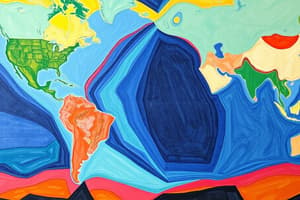Podcast
Questions and Answers
What is the primary evidence that supports the theory of Continental Drift?
What is the primary evidence that supports the theory of Continental Drift?
- Age of rocks increases with distance from mid-ocean ridges
- Fit of continents like a jigsaw puzzle and similarity of coastlines and rock formations (correct)
- Seafloor spreading and hotspots
- Magnetic stripes on either side of mid-ocean ridges
What is the process by which new oceanic crust is created at mid-ocean ridges?
What is the process by which new oceanic crust is created at mid-ocean ridges?
- Plate Tectonics
- Continental Drift
- Seafloor spreading (correct)
- Earth's Crust formation
What is the theory that describes the movement of the Earth's lithosphere?
What is the theory that describes the movement of the Earth's lithosphere?
- Seafloor Spreading
- Plate Tectonics (correct)
- Continental Drift
- Earth's Crust formation
What are the three types of plate boundaries according to Plate Tectonics?
What are the three types of plate boundaries according to Plate Tectonics?
What is the composition of the continental crust?
What is the composition of the continental crust?
What is the approximate thickness of the oceanic crust?
What is the approximate thickness of the oceanic crust?
What is the process that explains geological phenomena such as earthquakes, volcanoes, and mountain building?
What is the process that explains geological phenomena such as earthquakes, volcanoes, and mountain building?
What is the outermost solid layer of the Earth?
What is the outermost solid layer of the Earth?
Flashcards are hidden until you start studying
Study Notes
Lithosphere
Continental Drift
- Theory proposing that continents have moved over time
- Evidence:
- Fit of continents like a jigsaw puzzle
- Similarity of coastlines and rock formations
- Fossil evidence of same age and species found on different continents
- Proposed by Alfred Wegener in the early 20th century
Seafloor Spreading
- Process by which new oceanic crust is created at mid-ocean ridges
- Evidence:
- Magnetic stripes on either side of mid-ocean ridges
- Age of rocks increases with distance from mid-ocean ridges
- Hotspots and volcanic island chains
- Supports the theory of plate tectonics
Plate Tectonics
- Theory that describes the movement of the Earth's lithosphere
- Key concepts:
- Lithosphere broken into several large plates
- Plates move relative to each other at their boundaries
- Three types of plate boundaries: divergent, convergent, and transform
- Explains geological phenomena such as earthquakes, volcanoes, and mountain building
Earth's Crust
- Outermost solid layer of the Earth
- Composition:
- Continental crust: thicker, less dense, and composed of granite
- Oceanic crust: thinner, denser, and composed of basalt
- Thickness:
- Continental crust: 30-50 km
- Oceanic crust: 5-10 km
- Divided into several large plates that move relative to each other
Lithosphere
Continental Drift
- Proposed by Alfred Wegener in the early 20th century
- Theory that continents have moved over time
- Evidence includes:
- Fit of continents like a jigsaw puzzle
- Similarity of coastlines and rock formations
- Fossil evidence of same age and species found on different continents
Seafloor Spreading
- Process by which new oceanic crust is created at mid-ocean ridges
- Evidence includes:
- Magnetic stripes on either side of mid-ocean ridges
- Age of rocks increases with distance from mid-ocean ridges
- Hotspots and volcanic island chains
- Supports the theory of plate tectonics
Plate Tectonics
- Theory that describes the movement of the Earth's lithosphere
- Key concepts include:
- Lithosphere broken into several large plates
- Plates move relative to each other at their boundaries
- Three types of plate boundaries: divergent, convergent, and transform
- Explains geological phenomena such as:
- Earthquakes
- Volcanoes
- Mountain building
Earth's Crust
- Outermost solid layer of the Earth
- Composition:
- Continental crust: thicker, less dense, and composed of granite
- Oceanic crust: thinner, denser, and composed of basalt
- Thickness:
- Continental crust: 30-50 km
- Oceanic crust: 5-10 km
- Divided into several large plates that move relative to each other
Studying That Suits You
Use AI to generate personalized quizzes and flashcards to suit your learning preferences.




